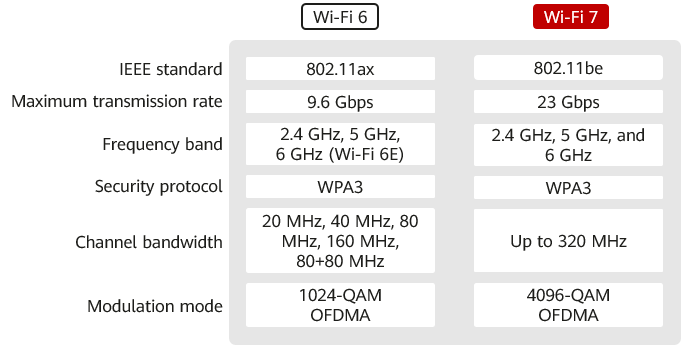What Is WiFi 7?
WiFi 7 (Wi-Fi 7) is the next-generation Wi-Fi standard to be launched, also known as IEEE 802.11be — extremely high throughput (EHT).
Based on Wi-Fi 6, Wi-Fi 7 introduces technologies such as 320 MHz bandwidth, 4096-quadrature amplitude modulation (QAM), multiple resource unit (MRU), multi-link operation (MLO), and multi-access point (AP) coordination. Drawing on these cutting-edge technologies, Wi-Fi 7 delivers a higher data transmission rates and lower latency than Wi-Fi 6. Wi-Fi 7 is expected to support a throughput of up to 23 Gbps, about three times that of Wi-Fi 6.
Why Do We Need Wi-Fi 7?
With the development of WLAN technologies, homes and enterprises rely more and more on Wi-Fi for network access. In recent years, emerging applications have higher requirements on throughput and latency. Typical examples of these applications include 4K and 8K videos (involving a transmission rate of up to 20 Gbps), virtual reality (VR)/augmented reality (AR), online gaming (requiring latency of less than 5 ms), remote office, online video conferencing, and cloud computing. Facing such high requirements, Wi-Fi 6 — currently the latest Wi-Fi standard — is insufficient in spite of its dedication to improving user experience in high-density scenarios.
As such, the IEEE is about to release a new amendment entitled IEEE 802.11be EHT, also known as Wi-Fi 7.
Wi-Fi 7 Release Time
The IEEE 802.11be Task Group (TGbe) was formally established in May 2019, which is working on the development of 802.11be (Wi-Fi 7). The standard will be available in Release 1 and Release 2. The TGbe plans to release Draft 1.0 of 802.11be in 2021, and Release 1 will be available by the end of 2022. Release 2 is expected to be initiated at the beginning of 2022 and will be released at the end of 2024.
Wi-Fi 7 vs. Wi-Fi 6
Based on the Wi-Fi 6 standard, Wi-Fi 7 introduces a plurality of new technologies. The following compares Wi-Fi 6 and Wi-Fi 7.

Wi-Fi 7 vs. Wi-Fi 6
New Features in Wi-Fi 7
Wi-Fi 7 aims to further increase the WLAN throughput and provide low-latency access assurance. To achieve this goal, the standard defines modifications to both the physical layer (PHY) and MAC layer. Compared with Wi-Fi 6, Wi-Fi 7 brings the following technical innovations:
Up to 320 MHz Bandwidth
The 2.4 GHz and 5 GHz frequency bands are unlicensed spectrums that limited and congested. When running emerging applications (such as VR/AR), existing Wi-Fi networks inevitably encounter low quality of service (QoS). To increase the maximum throughput, Wi-Fi 7 will support the 6 GHz of frequency band and extend new bandwidth modes, including contiguous 240 MHz, non-contiguous 160+80 MHz, contiguous 320 MHz, and non-contiguous 160+160 MHz.
MRU
In Wi-Fi 6, each user can send or receive frames only on the RUs allocated to them, which greatly limits the flexibility of spectrum resource scheduling. To resolve this problem and further improve spectrum efficiency, Wi-Fi 7 defines a mechanism for allocating multiple RUs to a single user. To balance the implementation complexity and spectrum utilization, the standard specifications impose certain restrictions on RU combination. That is, small RUs (containing fewer than 242 tones) can be combined only with small RUs, and large RUs (containing greater than or equal to 242 tones) can be combined only with large RUs. Small RUs and large RUs can be combined together.
Higher-Order 4096-QAM
The highest order modulation supported by Wi-Fi 6 is 1024-QAM, which allows each modulation symbol to carry up to 10 bits. To further improve the rate, Wi-Fi 7 introduces 4096-QAM so that each modulation symbol can carry 12 bits. With the same coding, 4096-QAM in Wi-Fi 7 can achieve a 20% rate increase compared with 1024-QAM in Wi-Fi 6.
Multi-Link Mechanism
To efficiently utilize all available spectrum resources, the industry is in urgent need to introduce new spectrum management, coordination, and transmission mechanisms on the 2.4 GHz, 5 GHz, and 6 GHz frequency bands. The 802.11 Working Group defines multi-link aggregation technologies, including the MAC architecture of enhanced multi-link aggregation, multi-link channel access, and multi-link transmission.
Multi-AP Coordination
In the current 802.11 protocol framework, there is not much coordination between APs. Common WLAN functions, such as automatic radio calibration and smart roaming, are vendor-defined features. Multi-AP coordination aims to optimize channel selection and adjust loads between APs to achieve efficient utilization and balanced allocation of radio resources. Coordinated scheduling between multiple APs in Wi-Fi 7 involves inter-cell coordinated planning in the time and frequency domains, inter-cell interference coordination, and distributed MIMO. This reduces interference between APs and greatly improves the utilization of air interface resources.
Multi-AP coordination can be implemented in various methods, such as coordinated orthogonal frequency division multiple access (C-OFDMA), coordinated spatial reuse (CSR), coordinated beamforming (CBF), and joint transmission (JXT).
Wi-Fi 7 Application Scenarios
New functions introduced by Wi-Fi 7 will significantly improve the data transmission rate and deliver lower latency. These highlights will contribute to the development of emerging applications:
- Video stream
- Video/Voice conference
- Online gaming
- Real-time collaboration
- Cloud/Edge computing
- Industrial IoT
- Immersive AR/VR
- Interactive telemedicine
- Author: Zhou Xia
- Updated on: 2023-11-16
- Views: 50871
- Average rating:







